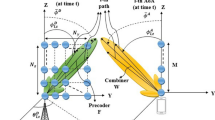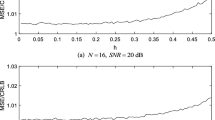Abstract
A new method is proposed to estimate the direction-of-arrival (DOA) based on uniform linear array sampling and named as sparsity and temporal correlation exploiting (SaTC-E). By exploiting the structure information of source signals, including spatial sparsity and temporal correlation of sources, SaTC-E accomplishes DOA estimation with superior performance via block sparse bayesian learning methodology and grid refined strategy. SaTC-E is applicable into time-varying manifold scenario, such as wideband sources, time-varying array, provided that the array manifold matrix is determinable. It has improved performance with some other merits, including superior resolution, requirement for a few snapshots, no knowledge of source number, and applicability to spatially and temporally corrected sources. Real data tests and numerical simulations are carried out to demonstrate the advantages of SaTC-E.







Similar content being viewed by others
References
Baraniuk, R. (2007). Compressive sensing. IEEE Signal Processing Magazine, 24(4), 118–124.
Candes, E., Romberg, J., & Tao, T. (2006). Robust uncertainty principles: Exact signal reconstruction from highly incomplete frequency information. IEEE Transactions on Information Theory, 52(2), 489–509.
Carlin, M., Rocca, P., Oliveri, G., et al. (2013). Directions-of-arrival estimation through bayesian compressive sensing strategies. IEEE Transactions on Antennas and Propagation, 61(7), 3828–3838.
Dempster, A., Laird, N., & Rubin, D. (1977). Maximum likelihood from incomplete data via the EM algorithm. Journal of the Royal Statistical Society, Series B (Methodological), 39(1), 1–38.
Donoho, D. (2006). Compressed sensing. IEEE Transactions on Information Theory, 52(4), 1289–1306.
Du, X. P., & Cheng, L. Z. (2014). Three stochastic measurement schemes for direction-of-arrival estimation using compressed sensing method. Multidimensional Systems and Signal Processing, 25(4), 621–636.
Eldar, Y., & Mishali, M. (2009). Robust recovery of signals from a structured union of subspaces. IEEE Transactions on Information Theory, 55(11), 5302–5316.
Guo, X. S., Wan, Qun, Chang, C. Q., & Lam, E. Y. (2010). Source localization using a sparse representation framework to achieve superresolution. Multidimensional Systems and Signal Processing, 21(4), 391–402.
Hyder, M., & Mahata, K. (2010). Direction-of-arrival estimation using a mixed \(l_{2,0}\) norm approximation. IEEE Transactions on Signal Processing, 58(9), 4646–4655.
Kim, J., Lee, O., & Ye, J. (2012). Compressive MUSIC: Revisiting the link between compressive sensing and array signal processing. IEEE Transactions on Information Theory, 58(1), 278–301.
Liu, Z., Huang, Z., & Zhou, Y. (2012). An efficient maximum likelihood method for direction-of-arrival estimation via sparse bayesian learning. IEEE Transactions on Wireless Communications, 11(10), 3607–3617.
Malioutov, D., Cetin, M., & Willsky, A. (2005). A sparse signal reconstruction perspective for source localization with sensor arrays. IEEE Transactions on Signal Processing, 53(8), 3010–3022.
Northardt, E., Bilik, I., & Abramovich, Y. (2013). Spatial compressive sensing for direciton-of-arrival estimation with bias mitigation via expected likelihood. IEEE Transactions on Signal Processing, 61(5), 1183–1195.
Schmidt, R. (1986). Multiple emitter location and signal parameter estimation. IEEE Transactions on Antennas and Propagation, 34(3), 276–280.
Stoica, P., & Nehorai, A. (1989). MUSIC, maximum likelihood and Cramer–Rao bound. IEEE Transactions on Acoustics Speech and Signal Processing, 37(5), 720–741.
Tipping, M. (2001). Sparse bayesian learning and the relevance vector machine. Journal of Machine Learning Research, 1, 211–244.
Valaee, S., & Kabal, P. (1995). Wideband array processing using a two-side correlation transformation. IEEE Transactions on Signal Processing, 43(1), 160–172.
Wan, J., Zhang, Z., Yan, J., et al. (2012). Sparse bayesian multi-task learning for predicting cognitive outcomes from neuroimaging measures in Alzheimer’s disease. In Proceedings of the IEEE international conference on computer vision and pattern recognition (CVPR) (pp. 940–947), Providence, Rhode Island, June 2012.
Wang, H., & Kaveh, M. (1985). Coherent signal-subspace processing for the detection and estimation of angles of arrival of multiple wideband sources. IEEE Transactions on Acoustics Speech and Signal Processing, 33(4), 823–831.
Wipf, D., Rao, B., & Nagarajan, S. (2011). Latent variable Bayesian models for promoting sparsity. IEEE Transactions on Information Theory, 57(9), 6236–6255.
Zhang, Z., Jung, T., Makeig, S., et al. (2013). Compressed sensing of EEG for wireless telemonitoring with low energy consumption and inexpensive hardware. IEEE Transactions on Biomedical Engineering, 60(1), 221–224.
Zhang, Z., Jung, T., Makeig, S., et al. (2013). Compressed sensing for energy-efficient wireless telemonitoring of noninvasive fetal ECG via block sparse bayesian learning. IEEE Transactions on Biomedical Engineering, 60(2), 300–309.
Zhang, Z., & Rao, B. (2011). Sparse signal recovery with temporally correlated source vectors using sparse bayesian learning. IEEE Journal of Selected Topics in Signal Processing, 5(5), 912–926.
Zhang, Z., & Rao, B. (2013). Extension of SBL algorithms for the recovery of block sparse signals with intra-block correlation. IEEE Transactions on Signal Processing, 61(8), 2009–2015.
Zhu, W., & Chen, B. X. (2015). Novel methods of DOA estimation based on compressed sensing. Multidimensional Systems and Signal Processing, 26(1), 113–123.
Author information
Authors and Affiliations
Corresponding author
Additional information
This research was supported by the National Natural Science Foundation of China under Grants (Nos. 61205190, 61201332 and 61471369) and Basic Research Plan of NUDT (No. JC13-02-03).
Appendices
Appendix 1
The detail for the derivatives (20) is presented as follows.
Let \(\mathbf {W}= {{\varvec{\Sigma }}_{-k}}+{{\tilde{\gamma }}_{k}}{\mathbf {a}}\left( {{{\tilde{\vartheta }}}_{k}} \right) {{{\mathbf {a}}}^{H}}\left( {{{\tilde{\vartheta }}}_{k}} \right) \otimes \mathbf {B},\) and the derivatives are expressed as
Employing the matrix differential formulas that
where \(\mathbf {W}\) is a conjugated symmetrical matrix, and \(\mathbf {d}\left( {{{\tilde{\vartheta }}}_{k}}\right) ={\partial {\mathbf {a}}\left( {{{\tilde{\vartheta }}}_{k}}\right) }/{\partial {{{\tilde{\vartheta }}}_{k}}}\;\), and let \(\mathbf {V}={{\mathbf {W}}^{-1}}-{{\mathbf {W}}^{-1}}{\mathbf {z}} {{{\mathbf {z}}}^{H}}{{\mathbf {W}}^{-1}}\), we have
In terms of the singular value decomposition (SVD), \(\mathbf {B}\) can be rewritten as
with \({r}_{\mathbf {B}}={\text {rank}}\left( \mathbf {B} \right) \) and \(\mathbf {u}_{i}^\mathbf {B}\) being the product of the ith singular value and the associated eigenvector of \(\mathbf {B}\), So that
The derivation is accomplished.
Appendix 2
Proof of Proposition 2
when \(\mathbf {B}={{{\mathbf {I}}}_{L}}\), we get \({{\varvec{\Sigma }}_{-k}}={{{\breve{{\varvec{\Sigma }} }}}_{-k}}\otimes {{{\mathbf {I}}}_{L}}\), and then \(L\left( {{{\tilde{\gamma }}}_{k}},{{{\tilde{\vartheta }}}_{k}} \right) \) can be rewritten as
and the first term of \(L\left( {{{\tilde{\gamma }}}_{k}},{{{\tilde{\vartheta }}}_{k}} \right) \) equals to the first term of \(\breve{L}\left( {{{\tilde{\gamma }}}_{k}},{{{\tilde{\vartheta }}}_{k}} \right) \), because
Let \(\mathbf {Q}= {{\left( {{{{\breve{{\varvec{\Sigma }} }}}}_{-k}}+{{{\tilde{\gamma }}}_{k}}{\mathbf {a}}\left( {{{\tilde{\vartheta }}}_{k}} \right) {{{\mathbf {a}}}^{H}}\left( {{{\tilde{\vartheta }}}_{k}} \right) \right) }^{-1}}\), and write the array output matrix \({\mathbf {Y}}\) as the form of
so that \({{{\mathbf {z}}}^{T}}=\left[ {{{\mathbf {y}}}_{1}} \, {{{\mathbf {y}}}_{2}} \, \ldots \, {{{\mathbf {y}}}_{M}} \right] \in {{{\mathbb {C}}}^{1\times ML}}\). The second terms of \(L\left( {{{\tilde{\gamma }}}_{k}},{{{\tilde{\vartheta }}}_{k}} \right) \) and \(\breve{L}\left( {{{\tilde{\gamma }}}_{k}},{{{\tilde{\vartheta }}}_{k}} \right) \) can be calculated, respectively, as
Because of \({{{\mathbf {y}}}_{j}}{\mathbf {y}}_{i}^{H}= \sum \limits _{k=1}^{L}{{{y}_{jk}}{{{\bar{y}}}_{ik}}} ={{\bar{\mathbf {y}}}_{i}}{\mathbf {y}}_{j}^{T}\), we have
and thus Proposition 2 is proved. \(\square \)
Rights and permissions
About this article
Cite this article
Lin, B., Liu, J., Xie, M. et al. A new direction-of-arrival estimation method exploiting signal structure information. Multidim Syst Sign Process 28, 183–205 (2017). https://doi.org/10.1007/s11045-015-0339-2
Received:
Revised:
Accepted:
Published:
Issue Date:
DOI: https://doi.org/10.1007/s11045-015-0339-2




